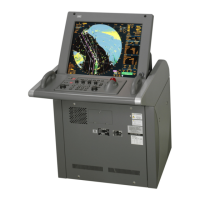A-9
A.3
REFERENCE
Preheat Time after Change of Connection Pattern
After the current interswitch connection pattern has been changed, operation needs to wait until the
system is ready. This is because the preheat time varies depending on the previous connection of the
scanner unit and display unit.
The wait time is necessary for protecting the electronic tubes that emit radio waves.
a) When not changed to a new connection pattern : Preheating not required
b) When changed to a new connection pattern and
an scanner unit had been used before the change : Preheating not required
c) When changed to a new connection pattern and
an scanner unit had not been used before the change : Preheating required
Notes on Changing Connection Pattern
An attempt to change to another connection pattern directly after the completion of connection pattern
change may fail.
This is because internal processing still needs some preparation time upon completion of connection
pattern change. Let several seconds pass between connection pattern change operations.
Notes on Connecting Slave Display Unit
Before a slave display unit can be placed in transmission state, the master display unit must be placed
in transmission state. If the master display unit is moved from the transmission state to the
transmission standby state, the slave display unit is forcibly placed in transmission standby state.
When they are in transmission standby state,
MTR Standby is shown in the alarm indication
column at the lower right of the display, and the
alarm sounds.
A slave display unit cannot control tune. Tune is controlled by the master display unit. Slave is
shown in the transmitter pulse length at upper left of the display.
Range change for a slave display unit is limited by the range and pulse length / repetition frequency of
the master display unit. As a rule, a greater range than the range of the master display unit cannot be
set for a slave display unit. However, if the transmitter pulse length of a slave display unit is identical
to the master display unit's and the repetition frequency is within the master display unit's, a greater
range than the master display unit's can be selected for the slave display unit. When the master display
unit narrows the range or changes the transmitter pulse length, the range of the slave display unit may
be forcibly changed. In this case, Master Range CHG is shown in the alarm indication (Brilliance /
alarm at lower right of the display), and the alarm sounds.

